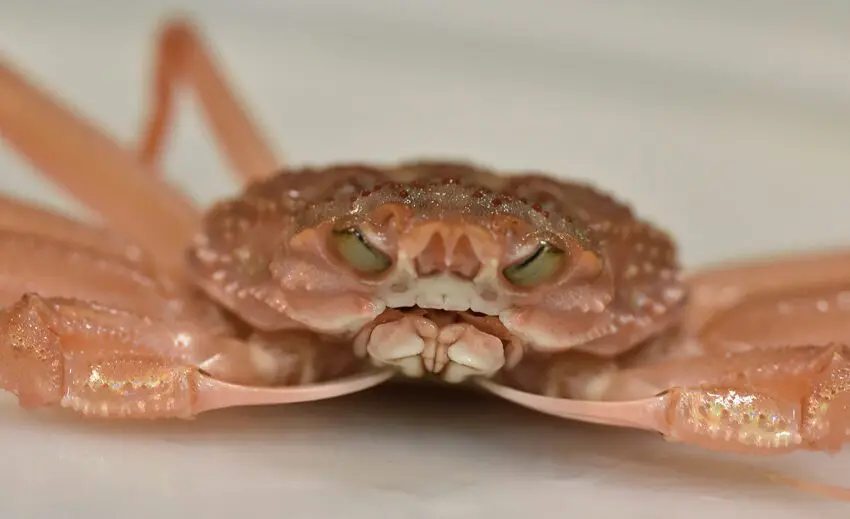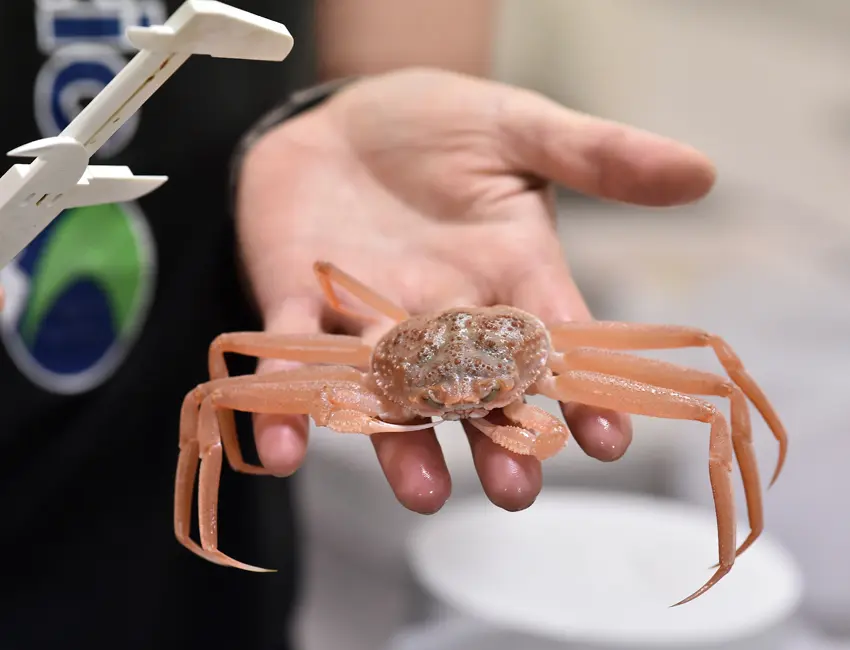The snow crab has arrived!

This snow crab was captured in Raudfjorden in northern Spitsbergen last week. Photo: Fredrik Broms/Akvaplan-niva
This snow crab was captured in Raudfjorden in northern Spitsbergen last week. Photo: Fredrik Broms/Akvaplan-niva.
Snow crab has been found in Raudfjorden in northern Spitsbergen for the first time. The speed of which it spreads indicates that it soon will be found along the western coast of Svalbard. Does this mean that a new source of income is literally crabbing in to Longyearbyen?
25 August 2017
Text: Jørgen Berge (Arctic University of Norway – UiT; UNIS and NTNU), Paul Renaud (Akvaplan-niva and UNIS), Bodil Bluhm (UiT) and Hanna Danielsen (UiT).
In a ten-year period from the mid-1870s, there was intensive cod fishing on and around Svalbard, with almost 600,000 cod caught only in Kongsfjorden during the peak year 1879. In 1883 this fishery collapsed, and the 18 boats that went from the mainland up to Kongsfjorden that year returned with only three cod. During the twentieth century there has been observed and fished a lot of cod in Svalbard, and since 2006 we have seen a steady stream of other “new” species in the fjords on the west coast of Svalbard, such as haddock, pollock, helmet jellyfish, mackerel and blue mussels to name a few. Now it also seems that the snow crab is on the go!
In recent years, it has been well documented how Atlantic (southern) marine species have migrated north and settled in and around Svalbard. For example, sample collections done on UNIS field courses have reported findings of blue mussels, mackerel, and helmet jellyfish. Although these are important findings, they may not have as far-reaching consequences for Svalbard and Norway in general as the observations we recently made of snow crab in Raudfjorden in northeastern Spitsbergen. On the AB-321/821 course cruise last week, we found young (3-5 years) snow crabs in the trawl and observed snow crabs on photographs from an automatic observatory located on the seabed. This is the first observation of snow crab in a Svalbard fjord. Previously, there have been two observations of snow crab in the area east of Edgeøya (2011 and 2016). Finding two young individuals in Raudfjorden on the northern side of Svalbard, indicates that the snow crab has already spread rapidly northwards, and will most likely also appear soon in the fjords on the west coast of Svalbard.
Snow crab was observed for the first time in the Barents Sea at Gåsebanken in 1996, and has since spread rapidly. It is now found in large amounts in the central and northeastern Barents Sea, where the fishing for this attractive crab has already reached a value of NOK 500 million annually. In Norway, the Institute of Marine Research, in collaboration with the Arctic University of Norway (UiT), conduct population studies of snow crabs in the Barents Sea. Master student Hanna Danielsen examines how many eggs a female crab can produce per breeding, whether the female crabs produce eggs every year and how big the crabs are when they start reproducing. This is important information in order to estimate the stock’s development. Until now, most of the information has come from the Bering Sea and the east coast of Canada, where the species has its original distribution.

Uncertain ecological effects
The snow crab typically lives on the soft bottom of the continental shelf, and has a diet consisting of a wide range of prey, including bristle worms, blue mussels, crustaceans, snake stars and even fish. There are no major studies that provide a clear answer to what kind of biological effects the snow crab establishment has, but a relative – the king crab – has had a demonstrable impact on the ecosystem where it has established itself in the Barents Sea and along the coast of northern Norway.
What effect the snow crab will have on the ecosystem around Svalbard is too early to say, but it will be naive to believe that it will not have any impact. At the same time, the coast on the west and north side of Svalbard is naturally strongly influenced by the relatively hot Atlantic waters flooding across the shelf and into the fjords. This is a natural phenomenon that has recently been greatly enhanced by climate change. The exact connection between a warmer global climate and increased influx of Atlantic waters in the Svalbard fjords is complex, but there is little doubt that there is a connection. However, in the context of a rapid and most likely man-made climate change, we also see a long-term pattern of rapid and powerful changes in the ocean climate in our fjords. The history of the cod in Svalbard over the past 150 years is a good and telling example of this. And now it seems that we can write a new chapter in this story, but this time with the snow crab in the lead role!
A new income source come crabbing in?
In 2007, researchers from UNIS, Arctic University of Norway – UiT and Akvaplan-niva conducted a survey in Isfjorden on the distribution of Malacostraca (crabs, shrimp, hermit crabs, etc.). This survey was carried out with the same tools and at the same stations as similar surveys from 1956 and 1906, in other words 50 and 100 years earlier. In 2007 we concluded that there were no changes of importance to track and that the same species were there, and in about the same relative number, as 50 years ago. If we had done the same survey today, 10 years afterwards, it is likely that we would have concluded differently! The consequences of the snow crab on Svalbard can potentially be significant, both ecologically and economically. And especially at a time when the commercial basis in Longyearbyen is changing, new sources of income may be “crabbing” into the fjords just in front of our eyes. Perhaps the next season of “Deadliest catch” will be recorded in Longyearbyen?
